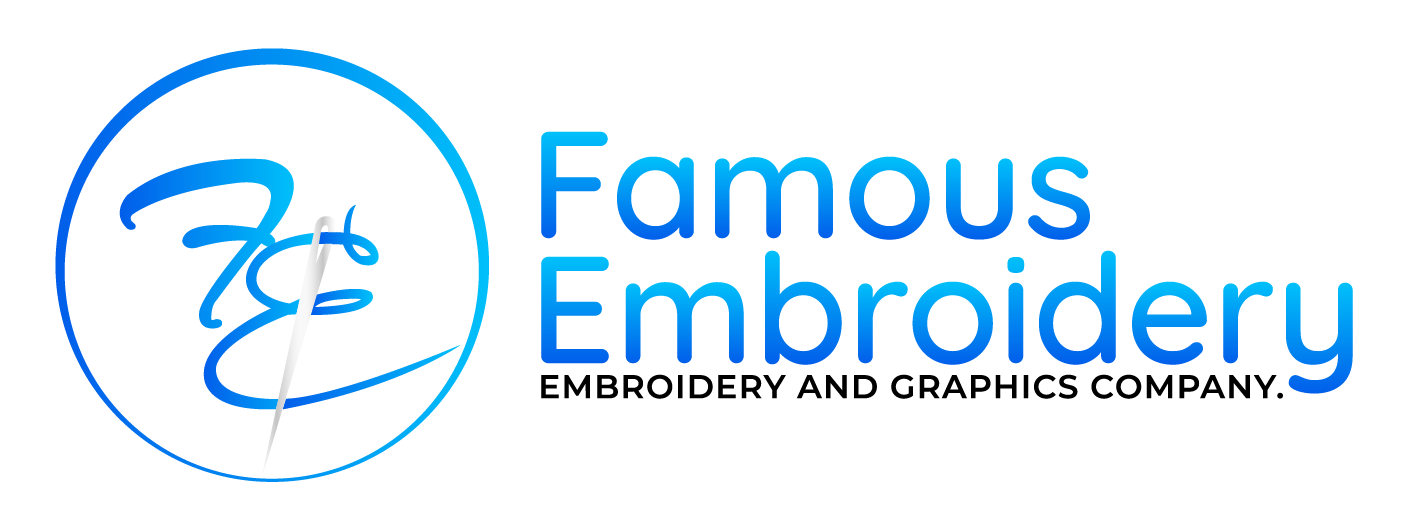To put it simply, embroidery digitizing is the process of converting the design into a digital file format through software that allows embroidery machines to understand the needle’s path. The process is not an automatic process and in fact, great digitizing is considered an art form if done correctly. Most embroidery machines have software of their own allowing us to control their functions while reading instructions from a file that has been digitized.
Digitize your designs in a way that your machines can easily understand before running their job. As a digitizer’s thinking, that means taking an image JPG or PNG file provided by customer logo or artwork design and converting that into an embroidery digitize file. The types of embroidery machines determine the embroidery digitized file type you will be using.
EMBROIDERY FILE TYPES BY MACHINE
.dst: embroidery file format for Tajima commercial embroidery machines
.exp: embroidery file format for Melco commercial embroidery machines
.jef: embroidery file format for Janome commercial embroidery machines
.kwk: embroidery file format for Brother commercial embroidery machines
.dsb: embroidery file format for Barudan commercial embroidery machines
.tap: embroidery file format for Happy commercial embroidery machines
THE BASIC STEPS OF DIGITZING
Step 1: Upload Your Logo to the Digitizing Software…
Step 2: Set Embroidery Design Size…
Step 3: Choose Your Stitch Type…
Step 4: Set Stitch Direction…
Step 5: Set Your Embroidery Thread Colors…
Step 6: Transfer the File to Your Embroidery Machine…
Design understanding is one of the important parts of digitizing. Size, complexity, and placement of the design will all factor into the digitizing process. Efficient embroidery digitizers (technically all digitizers if they are good) should consider fabric vs thread. Some specific designs look better to have the fabric show through as a color instant of lying thread down. It’s also important to assign embroidery stitch types to specific areas while considering factors such as the fabric type and “push and pull” of the garment. And many variables and directions that can affect the outcome of your stitching, so each job should be treated differently and handled with care.
PREPARING YOUR ARTWORK FOR DIGITIZING
Next, the digitizer must analyze the design artwork to see that the design should be edited for embroidery. The final size of the design digitized must be considered. All logos that are not designed for print media such as a business card will work well for embroidery. There we see many artworks that need to be modified or simplified. There are many designs that need must be modified or simplified. Sometimes we digitize only the design name and a small image is used. There we have to remove some components such as outlining and small text needs to be enlarged and rearranged to get better results.
CHOOSING YOUR STITCH TYPE
There we can use a different variety of stitch types that are used to accomplish different looks, textures, and more. There each stitch type has a maximum stitch length that must be taken into consideration. And also, should also consider fabric type and the “push and pull” of the garment when selecting stitch types. Here are the 3 most common machine embroidery stitch types.
STRAIGHT STITCH
The straight stitch is a foundational stitch for embroidery in which lines of stitches are repeated to make a design pattern. We can create straight lines thick by repeating stitches many times. An important note is that straight lines are not means that it’s just for creating straight lines. We can also create curved shapes lines too through the straight-line tool.
Straight Stitches are most commonly used for:
- Shading
- Outlining
- Detail work
SATIN STITCH
When we are going to have text embroidered, then the satin stitch is the best stitch type for us. Satin stitching has a shinier appearance that is ideal for lettering because of the longer thread length. We use a satin stitch length maximum of 12.1mm. satin stitches are most commonly used for…
•Words and text
•Borders
•Achieving a shiny look
FILL STITCH
The fill stitch also called the tatami stitch or the ceding stitch is used to fill in designs, as its name suggests. To give the embroidery a woven effect, fill stitches use alternate lines. Fill stitches have a maximum stitch length of 4mm. Fill Stitches are most commonly used for…
•Filling in blank space
•Creating a textured look
•Larger designs
•More durable applications
PUSH & PULL
The “push and pull” is another important aspect of embroidery. While being embroidered, a design may move. Some stitches will slip as a result of this. Bulky fabrics, long stitches, big amounts of thread, and a tight bobbin thread might cause this shifting. A digitizer must account for the possible effects of “push and pull”.
THE EMBROIDERY SEW OUT
Although many left breast business logos are very simple to digitize for an experienced digitizer, designs with fine detail, small lettering, color gradations, and multiple color changes require additional set-up time. Digitizing is a time-consuming procedure that demands patience and experience to master. The digitizer must understand how different fabrics will embroider the stitches he sees in his embroidery software. Your logo will benefit from a well-digitized design, so look for an embroiderer who offers high-quality digitization.
RECAP
The most important point here, as with most things in life, is that garbage in, garbage out. The sew-out will be better if your file is properly set up. There should be no shortcuts in this process, and with so many companies offering digitizing these days, finding the correct person or company for the job is crucial. We have multiple digitizers at Famous Embroidery, that we use depending on their experience and reputation. To begin your embroidery project, simply click the button below.

